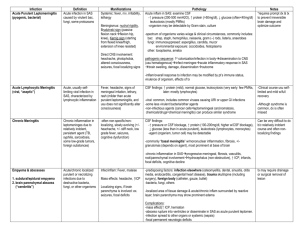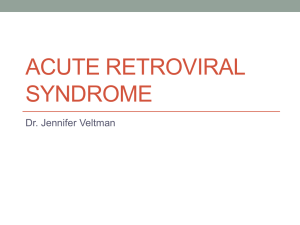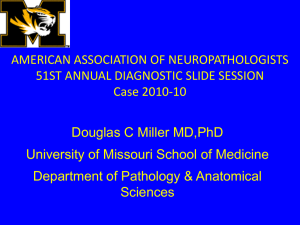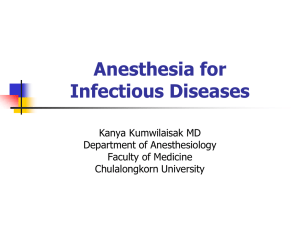Infection
advertisement
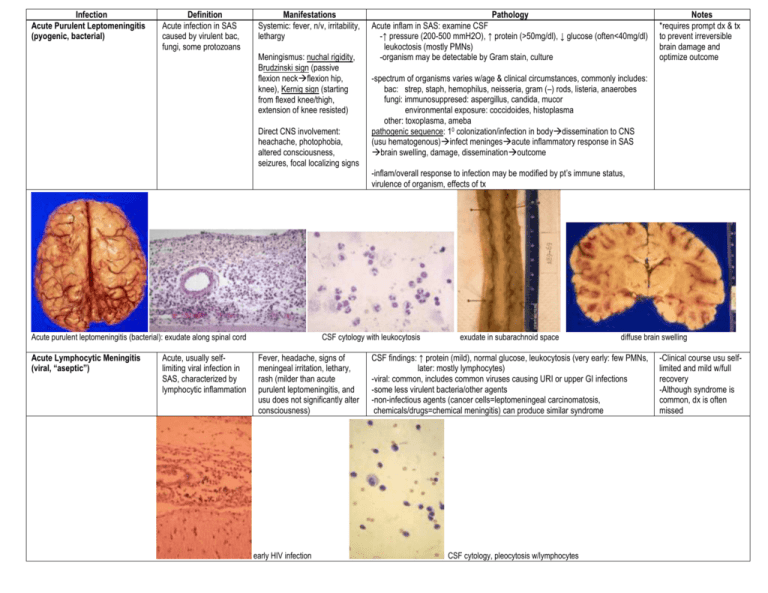
Infection Acute Purulent Leptomeningitis (pyogenic, bacterial) Definition Acute infection in SAS caused by virulent bac, fungi, some protozoans Manifestations Systemic: fever, n/v, irritability, lethargy Meningismus: nuchal rigidity, Brudzinski sign (passive flexion neckflexion hip, knee), Kernig sign (starting from flexed knee/thigh, extension of knee resisted) Direct CNS involvement: heachache, photophobia, altered consciousness, seizures, focal localizing signs Acute purulent leptomeningitis (bacterial): exudate along spinal cord Acute Lymphocytic Meningitis (viral, “aseptic”) Acute, usually selflimiting viral infection in SAS, characterized by lymphocytic inflammation Pathology Acute inflam in SAS: examine CSF -↑ pressure (200-500 mmH2O), ↑ protein (>50mg/dl), ↓ glucose (often<40mg/dl) leukoctosis (mostly PMNs) -organism may be detectable by Gram stain, culture -spectrum of organisms varies w/age & clinical circumstances, commonly includes: bac: strep, staph, hemophilus, neisseria, gram (–) rods, listeria, anaerobes fungi: immunosuppresed: aspergillus, candida, mucor environmental exposure: coccidoides, histoplasma other: toxoplasma, ameba pathogenic sequence: 10 colonization/infection in bodydissemination to CNS (usu hematogenous)infect meningesacute inflammatory response in SAS brain swelling, damage, disseminationoutcome -inflam/overall response to infection may be modified by pt’s immune status, virulence of organism, effects of tx CSF cytology with leukocytosis Fever, headache, signs of meningeal irritation, lethary, rash (milder than acute purulent leptomeningitis, and usu does not significantly alter consciousness) early HIV infection Notes *requires prompt dx & tx to prevent irreversible brain damage and optimize outcome exudate in subarachnoid space diffuse brain swelling CSF findings: ↑ protein (mild), normal glucose, leukocytosis (very early: few PMNs, later: mostly lymphocytes) -viral: common, includes common viruses causing URI or upper GI infections -some less virulent bacteria/other agents -non-infectious agents (cancer cells=leptomeningeal carcinomatosis, chemicals/drugs=chemical meningitis) can produce similar syndrome CSF cytology, pleocytosis w/lymphocytes -Clinical course usu selflimited and mild w/full recovery -Although syndrome is common, dx is often missed Chronic Meningitis Chronic inflammation in leptomeninges due to relatively indolent, persistent agent (TB, syphilis, sarcoidosis, some low-grade tumors, foreign substances) Exudate @ base of brain acid fast bacilli (TB): Ziehl-Neelsen stain Chronic meningitis complicated by vasculitis -often non-specific/nonlocalizing, slowly evolving (+/heachache, +/- stiff neck, low grade fever, seizures, cognitive dysfunction) CSF findings: -↑ pressure or CSF blockage, ↑ protein(100-200mg/dl, higher w/CSF blockage), ↓ glucose (less than in acute purulent), leukoctosis (lymphocytes, monocytes) -agent (organism, tumor cell) may be detectable -commonly “basal meningitis” w/mononuclear inflammation, fibrosis, +/granulomas (depends on agent), most prominent at base of brain Can be very difficult to dx b/c relatively indolent course and often nonlocalizing findings -chronic inflammation in SASprogressive meningeal, fibrosis, vasculitis, root/parenchymal involvementhydrocephalus (non-obstructive), ↑ ICP, infarcts, focal deficits, cognitive decline exudate in SAS Cryptococcal meningitis: cryptococci in SAS granulomas (due to TB) extension of org. into white matter along blood vessels Obliterative endarteritis w/arterial stenosis caseating granuloma w/giant cells (TB) Cryptococci: mucicarmine stain Brainstem infarct due to obliterative endarteritis Empyema & abscesses 1. subdural/epidural empyema 2. brain parenchymal abscess (“cerebritis”) Acute/chronic localized purulent or necrotizing infections due to destructive bacteria, fungi, or other organisms Subdural empyema (bacterial) involving right anterior and middle cranial fossas Exudate from lesion showing Candida (PAS stain) Infec/inflam: Fever, malaise Mass effects: headache, ↑ICP Localizing signs, if brain parenchyma is involved: ex. seizures, focal deficits -predisposing factors: infection elsewhere (osteomyelitis, dental, sinusitis, otitis media, endocarditis, congenital heart disease), trauma skull/spine (including surgery), foreign body (catheter, gauze, bullet) -bacteria, fungi, others tx may require drainage or surgical removal of lesion -localized area of tissue damage & acute/chronic inflam surrounded by reactive layer; brain parenchyma may show prominent edema Complications: -mass effect(↑ ICP, herniation -abscess rupture into ventricles or disseminate in SAS as acute purulent leptomen. -infection spread to other organs or systemic (sepsis) -focal permanent neurologic deficits Hemorrhagic necrosis (cerebritis) in occipital lobe, due to virulent organism (Aspergillus) Brain abscess (bacterial) in occipital lobe Multiple foci of necrosis (cerebritis), neonatal sepsis (Candida) Brain abscess (bacterial), micro Cerebritis (early brain abscess) in white matter due to Candida Brain abscess (toxoplasma), gross Acute Viral Encephalitis Acute viral infection of brain parenchyma +/meninges Prodrome of infection: fever, headache, malaiseacute onset neurologic sx (seizures, focal deficits, altered consciousness) -specific syndrome varies w/virus & location of infection -most viral infec display tissue tropism(=virus infects particular cell type) need specialized cell surface receptors -infections may be lytic or nonlytic to infected cell Syndrome Acute poliomyelitis Agent poliovirus Preferential Site of Involvement -ant horn destructionLMN paralysis Herpes/Zoster ganglionitis VZV -Trigeminal or DRG, w/pain, dermatomal distrib of vesicular rash Acute (meningo)encephalitis Acute necrotizing HSV 1 CMV Epidemic, seasonal Arbovirus -medial temporal lobes (Cowdry type A nuclear viral inclusions) -periventricular tissues (cytomegalic cells); occurs as congenital infection (TORCH) &immunocompromised -deep gray nuclei, cortex; variable syndromes; often transmitted by arthropod bites Rabies rabies virus -brainstem (cytoplasmic viral aggregates- Negri bodies); usu lethal Dx: 1-high index of suspicion based on history & exam 2-CSF: mild-moderate ↑protein, normal glucose, leukocytosis (+/-PMNs early acute, 50-500/ul lymphocytes) *more destructive infections show more dramatic changes 3-EEG – can help localize lesion 4-CT, MRI – can help localize and characterize lesion 5-serology, culture, or PCR assay for specific virus based on index of suspicion Pathogenesis: 1. infection of host w/transport of virus to CNS (hematogenous, some use axonal transport) 2. host response (lymphocytes, plasma cells, microglial cell proliferation; edema & vascular response; tissue or neuronal necrosis 3. outcome depends on virulence of virus, availability of anti-virals, degree of tissue damage Microglial nodule Cowdry type A viral inclusions in hippocampal nuclei (HSV1) Bilateral atrophy of medial temporal lobes due to previous Herpes encephalitis Viral inclusions demonstrated with Ab to HSV Cytomegalovirus, involving ependyma, in HIV patient Chronic (slow) viral encephalitis Progressive viral infection, w/prolonged incubation following initial exposure, insidious onset, slow progression of sx, due to conventional viral agents *prions excluded here Sx: slowly progressive dementia or loss of particular neurologic functions PML: focal demyelination in HIV pt Disease AIDS Dementia infection, destruction oligodendrocytesprogressive demyelination, usu in immunocompromised host SSPE(subacute sclerosing panencephalitis) measles diffuse brain involvement, kids/adolescents, ? related to unusu early 10 measles infection (this disease very rare) TSP(tropical spastic paraparesis) HTLV-1 progressive spastic leg weakness & sensory loss due to involvement of lower spinal cord; endemic or common in certain geographic areas HIV: syndromes include: 1) Acute Lymphocytic meningitis – often during 10 infection 2)Chronic HIV encephalitis w/ progressive dementia (AIDS dementia) 3)Vacuolar myelopathy – uncommon degeneration of posterior & lateral columns in spinal cord in chronic AIDS pt, resembles subacute combined degeneration seen in vitamin B12 deficiency 4)peripheral neuropathy (various types) 5)inflammatory myopathy (polymyositis-like) -opportunistic CNS infections: toxoplasma cerebritis, PML, CMV encephalitis, cyptococcus meningitis -risk of developing 10 CNS lymphoma (often related to EBV infection of lymphoid cells) – high grade B cell tumors, may be difficult to dx and tx -drug toxicity to neuromuscular system from anti-retroviral tx (ex. AZT myopathy) HIV patient: high-grade large B cell lymphoma HIV enceph: perivascular macrophages & multinucleate giant cells Special Features brain atrophy, demyelination, encephalitis w/monocytes & giant cells PML(progressive multifocal leukoencephalopathy) papovirus JC strain) PML: intranuclear inclusions in oligodendrocytes (papova) Toxoplasma (immunostained w/anti-Toxoplasma Ab) Agent HIV PML: intranuclear viral particles(papova) Toxoplasma abscesses in basal ganglia HIV pt Lymphoma in HIV pt infiltrating hypothalamus (grossly mimics glioma) HIV enceph: diffuse loss of myelin staining in white matter HIV encephalitis: perivascular macrophages HIV enceph: multiple foci of white matter damage HIV encephalitis: HIV Ag in infected monocytic cells demonstrated by immunostaining
